PSY-5504 Social Psychology: Annotated Outline on Aggression
VerifiedAdded on 2022/10/08
|7
|1214
|14
Report
AI Summary
This annotated outline explores the multifaceted concept of human aggression, examining its definitions, causes, and consequences. It delves into various theories, including the Cognitive Neoassociation Theory, to explain the development of aggressive behaviors, considering factors like provocation, frustration, and uncomfortable situations. The outline further investigates specific forms of aggression such as dating aggression and its relation to cognitive dissonance, as well as the impact of frustration, and the role of pleasure in violent behavior. The report also provides references to support the claims made in the outline. The conclusion highlights the need to understand the roots of aggression to mitigate its negative societal effects, advocating for the development of effective solutions to address this growing phenomenon.
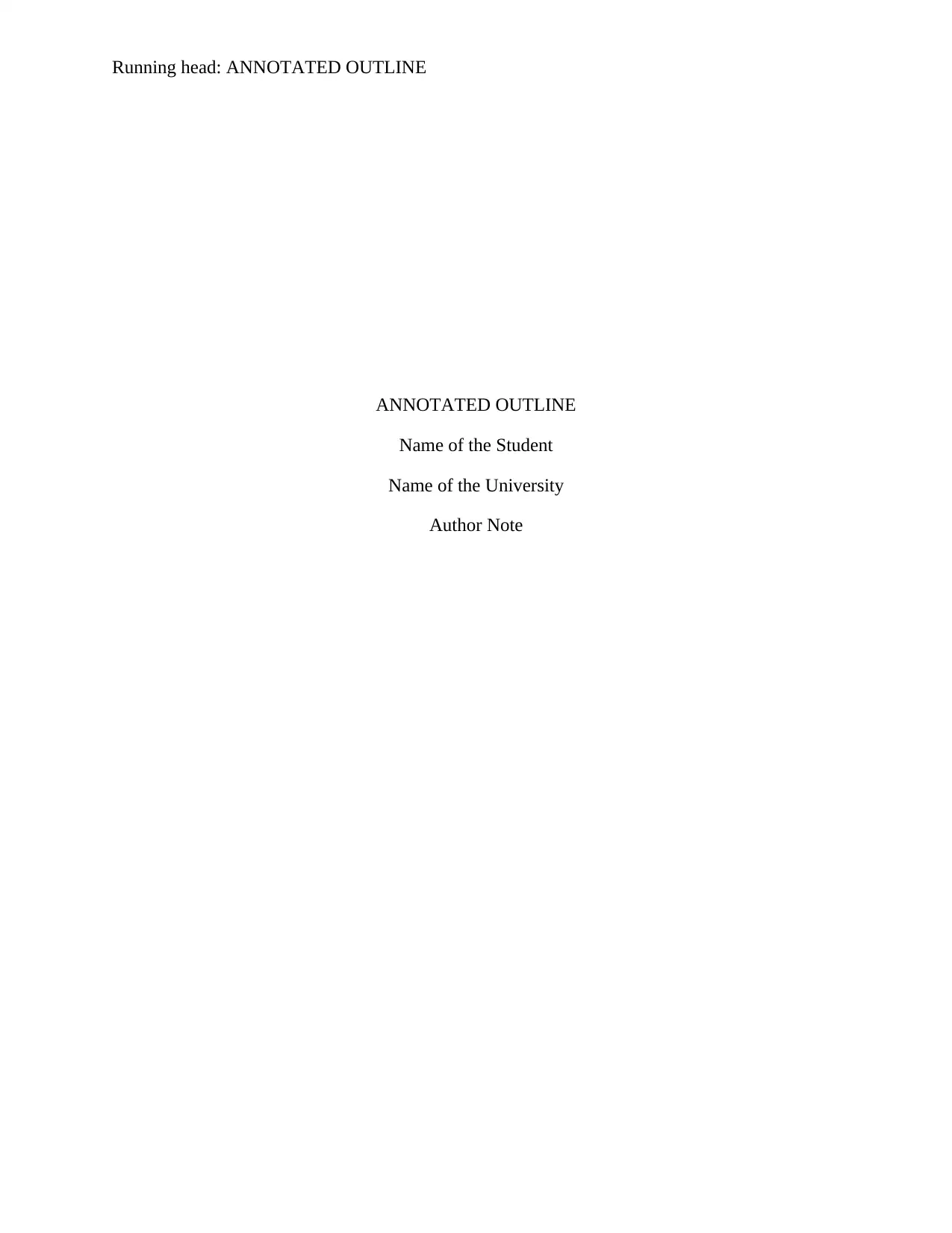
Running head: ANNOTATED OUTLINE
ANNOTATED OUTLINE
Name of the Student
Name of the University
Author Note
ANNOTATED OUTLINE
Name of the Student
Name of the University
Author Note
Paraphrase This Document
Need a fresh take? Get an instant paraphrase of this document with our AI Paraphraser
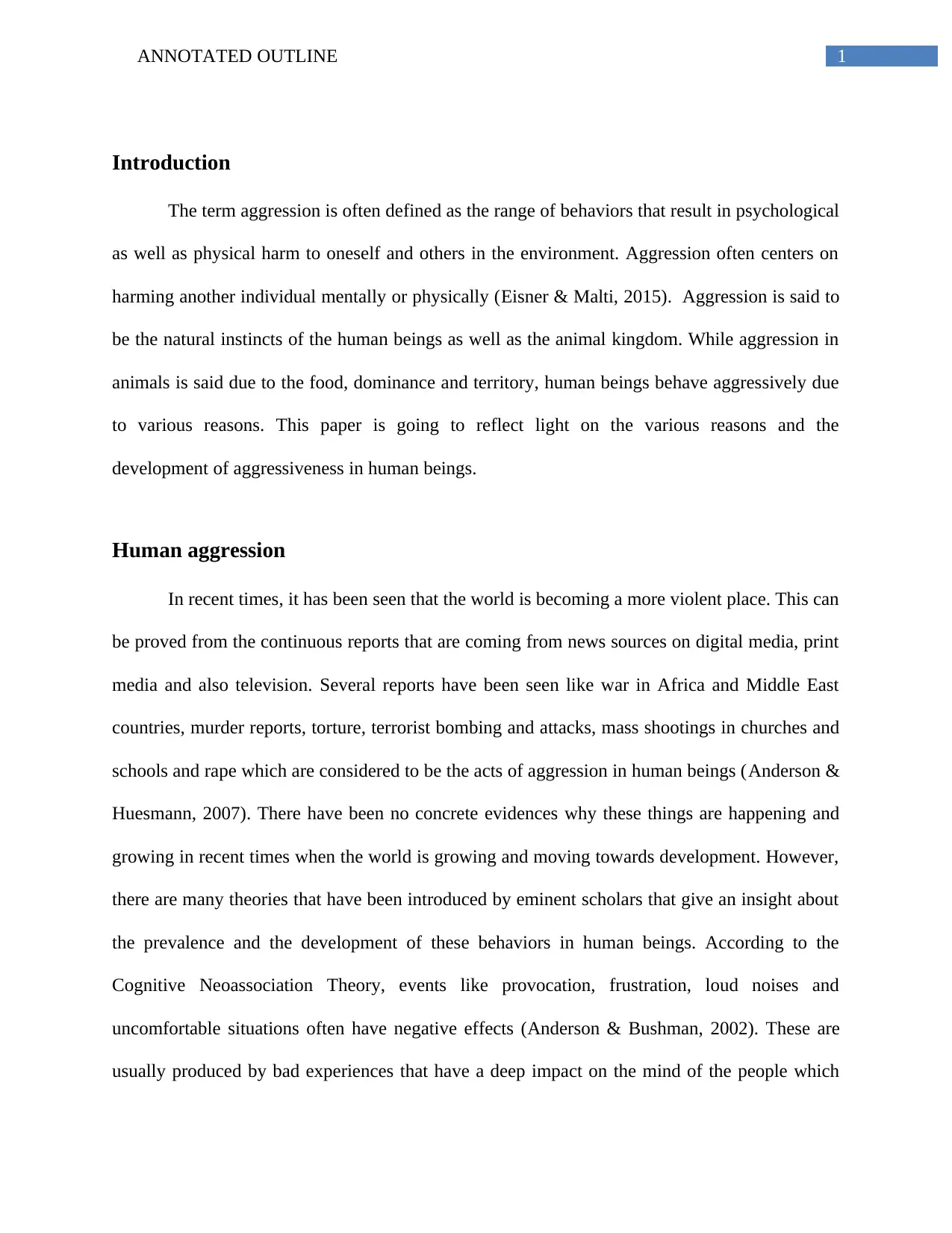
1ANNOTATED OUTLINE
Introduction
The term aggression is often defined as the range of behaviors that result in psychological
as well as physical harm to oneself and others in the environment. Aggression often centers on
harming another individual mentally or physically (Eisner & Malti, 2015). Aggression is said to
be the natural instincts of the human beings as well as the animal kingdom. While aggression in
animals is said due to the food, dominance and territory, human beings behave aggressively due
to various reasons. This paper is going to reflect light on the various reasons and the
development of aggressiveness in human beings.
Human aggression
In recent times, it has been seen that the world is becoming a more violent place. This can
be proved from the continuous reports that are coming from news sources on digital media, print
media and also television. Several reports have been seen like war in Africa and Middle East
countries, murder reports, torture, terrorist bombing and attacks, mass shootings in churches and
schools and rape which are considered to be the acts of aggression in human beings (Anderson &
Huesmann, 2007). There have been no concrete evidences why these things are happening and
growing in recent times when the world is growing and moving towards development. However,
there are many theories that have been introduced by eminent scholars that give an insight about
the prevalence and the development of these behaviors in human beings. According to the
Cognitive Neoassociation Theory, events like provocation, frustration, loud noises and
uncomfortable situations often have negative effects (Anderson & Bushman, 2002). These are
usually produced by bad experiences that have a deep impact on the mind of the people which
Introduction
The term aggression is often defined as the range of behaviors that result in psychological
as well as physical harm to oneself and others in the environment. Aggression often centers on
harming another individual mentally or physically (Eisner & Malti, 2015). Aggression is said to
be the natural instincts of the human beings as well as the animal kingdom. While aggression in
animals is said due to the food, dominance and territory, human beings behave aggressively due
to various reasons. This paper is going to reflect light on the various reasons and the
development of aggressiveness in human beings.
Human aggression
In recent times, it has been seen that the world is becoming a more violent place. This can
be proved from the continuous reports that are coming from news sources on digital media, print
media and also television. Several reports have been seen like war in Africa and Middle East
countries, murder reports, torture, terrorist bombing and attacks, mass shootings in churches and
schools and rape which are considered to be the acts of aggression in human beings (Anderson &
Huesmann, 2007). There have been no concrete evidences why these things are happening and
growing in recent times when the world is growing and moving towards development. However,
there are many theories that have been introduced by eminent scholars that give an insight about
the prevalence and the development of these behaviors in human beings. According to the
Cognitive Neoassociation Theory, events like provocation, frustration, loud noises and
uncomfortable situations often have negative effects (Anderson & Bushman, 2002). These are
usually produced by bad experiences that have a deep impact on the mind of the people which
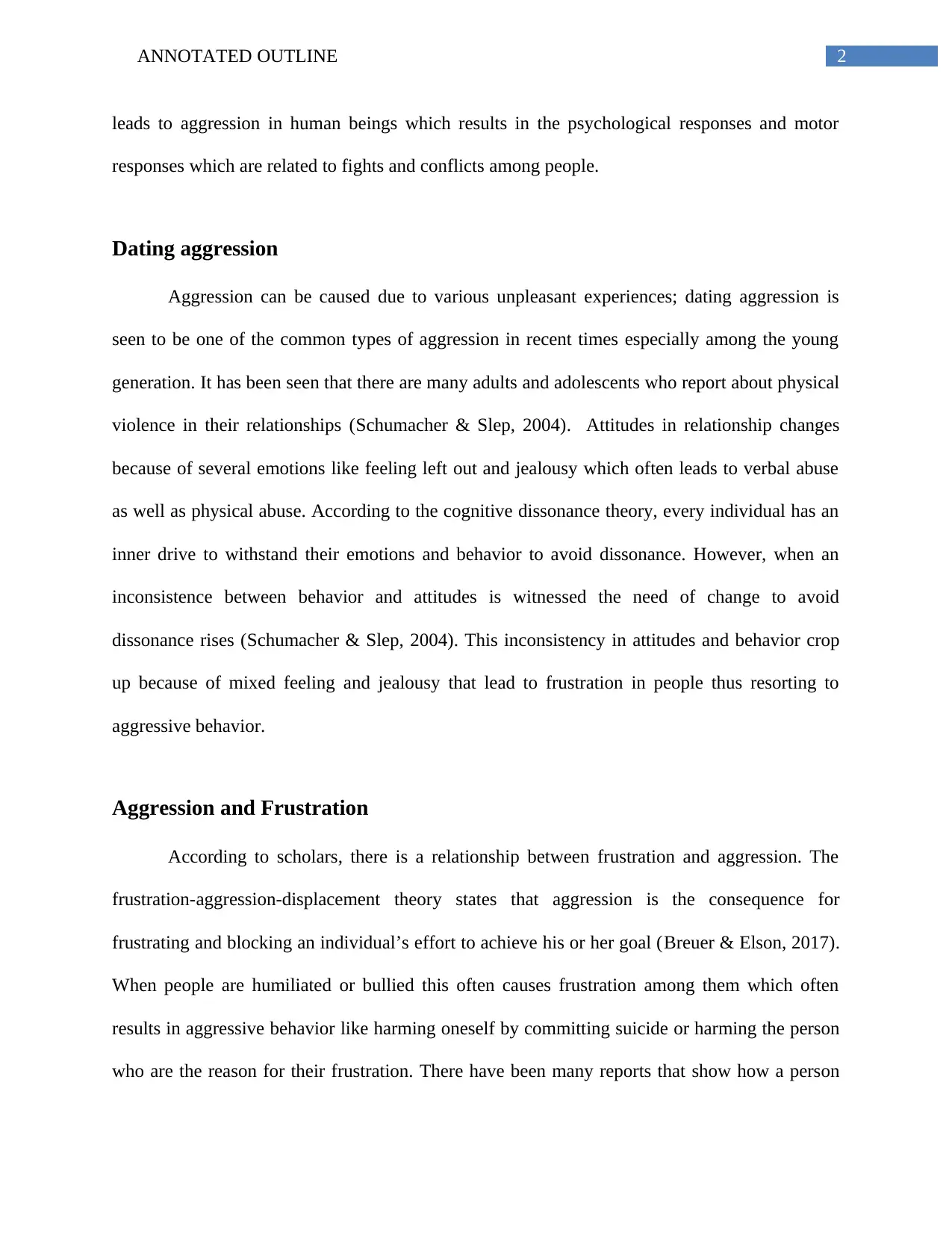
2ANNOTATED OUTLINE
leads to aggression in human beings which results in the psychological responses and motor
responses which are related to fights and conflicts among people.
Dating aggression
Aggression can be caused due to various unpleasant experiences; dating aggression is
seen to be one of the common types of aggression in recent times especially among the young
generation. It has been seen that there are many adults and adolescents who report about physical
violence in their relationships (Schumacher & Slep, 2004). Attitudes in relationship changes
because of several emotions like feeling left out and jealousy which often leads to verbal abuse
as well as physical abuse. According to the cognitive dissonance theory, every individual has an
inner drive to withstand their emotions and behavior to avoid dissonance. However, when an
inconsistence between behavior and attitudes is witnessed the need of change to avoid
dissonance rises (Schumacher & Slep, 2004). This inconsistency in attitudes and behavior crop
up because of mixed feeling and jealousy that lead to frustration in people thus resorting to
aggressive behavior.
Aggression and Frustration
According to scholars, there is a relationship between frustration and aggression. The
frustration-aggression-displacement theory states that aggression is the consequence for
frustrating and blocking an individual’s effort to achieve his or her goal (Breuer & Elson, 2017).
When people are humiliated or bullied this often causes frustration among them which often
results in aggressive behavior like harming oneself by committing suicide or harming the person
who are the reason for their frustration. There have been many reports that show how a person
leads to aggression in human beings which results in the psychological responses and motor
responses which are related to fights and conflicts among people.
Dating aggression
Aggression can be caused due to various unpleasant experiences; dating aggression is
seen to be one of the common types of aggression in recent times especially among the young
generation. It has been seen that there are many adults and adolescents who report about physical
violence in their relationships (Schumacher & Slep, 2004). Attitudes in relationship changes
because of several emotions like feeling left out and jealousy which often leads to verbal abuse
as well as physical abuse. According to the cognitive dissonance theory, every individual has an
inner drive to withstand their emotions and behavior to avoid dissonance. However, when an
inconsistence between behavior and attitudes is witnessed the need of change to avoid
dissonance rises (Schumacher & Slep, 2004). This inconsistency in attitudes and behavior crop
up because of mixed feeling and jealousy that lead to frustration in people thus resorting to
aggressive behavior.
Aggression and Frustration
According to scholars, there is a relationship between frustration and aggression. The
frustration-aggression-displacement theory states that aggression is the consequence for
frustrating and blocking an individual’s effort to achieve his or her goal (Breuer & Elson, 2017).
When people are humiliated or bullied this often causes frustration among them which often
results in aggressive behavior like harming oneself by committing suicide or harming the person
who are the reason for their frustration. There have been many reports that show how a person
⊘ This is a preview!⊘
Do you want full access?
Subscribe today to unlock all pages.

Trusted by 1+ million students worldwide
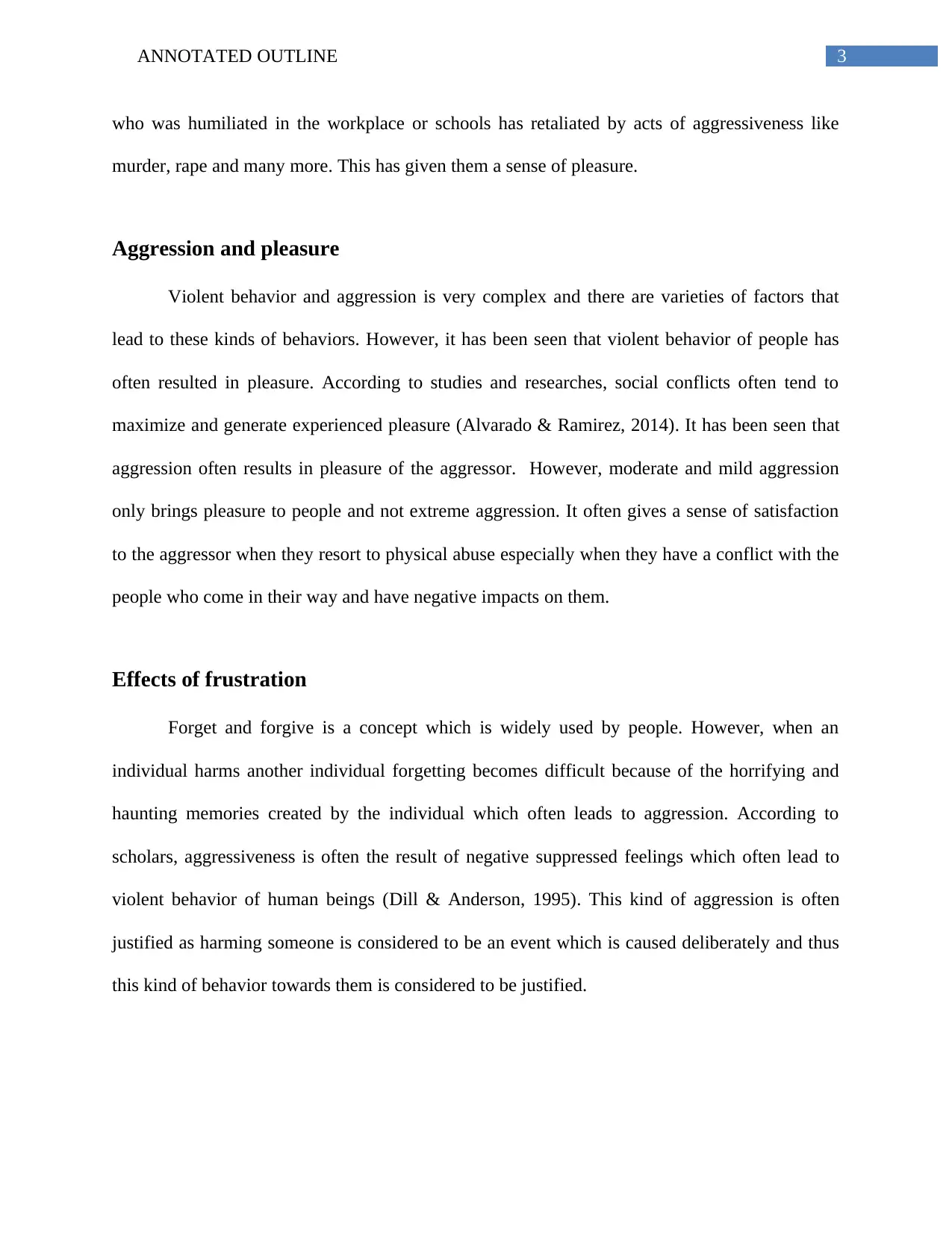
3ANNOTATED OUTLINE
who was humiliated in the workplace or schools has retaliated by acts of aggressiveness like
murder, rape and many more. This has given them a sense of pleasure.
Aggression and pleasure
Violent behavior and aggression is very complex and there are varieties of factors that
lead to these kinds of behaviors. However, it has been seen that violent behavior of people has
often resulted in pleasure. According to studies and researches, social conflicts often tend to
maximize and generate experienced pleasure (Alvarado & Ramirez, 2014). It has been seen that
aggression often results in pleasure of the aggressor. However, moderate and mild aggression
only brings pleasure to people and not extreme aggression. It often gives a sense of satisfaction
to the aggressor when they resort to physical abuse especially when they have a conflict with the
people who come in their way and have negative impacts on them.
Effects of frustration
Forget and forgive is a concept which is widely used by people. However, when an
individual harms another individual forgetting becomes difficult because of the horrifying and
haunting memories created by the individual which often leads to aggression. According to
scholars, aggressiveness is often the result of negative suppressed feelings which often lead to
violent behavior of human beings (Dill & Anderson, 1995). This kind of aggression is often
justified as harming someone is considered to be an event which is caused deliberately and thus
this kind of behavior towards them is considered to be justified.
who was humiliated in the workplace or schools has retaliated by acts of aggressiveness like
murder, rape and many more. This has given them a sense of pleasure.
Aggression and pleasure
Violent behavior and aggression is very complex and there are varieties of factors that
lead to these kinds of behaviors. However, it has been seen that violent behavior of people has
often resulted in pleasure. According to studies and researches, social conflicts often tend to
maximize and generate experienced pleasure (Alvarado & Ramirez, 2014). It has been seen that
aggression often results in pleasure of the aggressor. However, moderate and mild aggression
only brings pleasure to people and not extreme aggression. It often gives a sense of satisfaction
to the aggressor when they resort to physical abuse especially when they have a conflict with the
people who come in their way and have negative impacts on them.
Effects of frustration
Forget and forgive is a concept which is widely used by people. However, when an
individual harms another individual forgetting becomes difficult because of the horrifying and
haunting memories created by the individual which often leads to aggression. According to
scholars, aggressiveness is often the result of negative suppressed feelings which often lead to
violent behavior of human beings (Dill & Anderson, 1995). This kind of aggression is often
justified as harming someone is considered to be an event which is caused deliberately and thus
this kind of behavior towards them is considered to be justified.
Paraphrase This Document
Need a fresh take? Get an instant paraphrase of this document with our AI Paraphraser
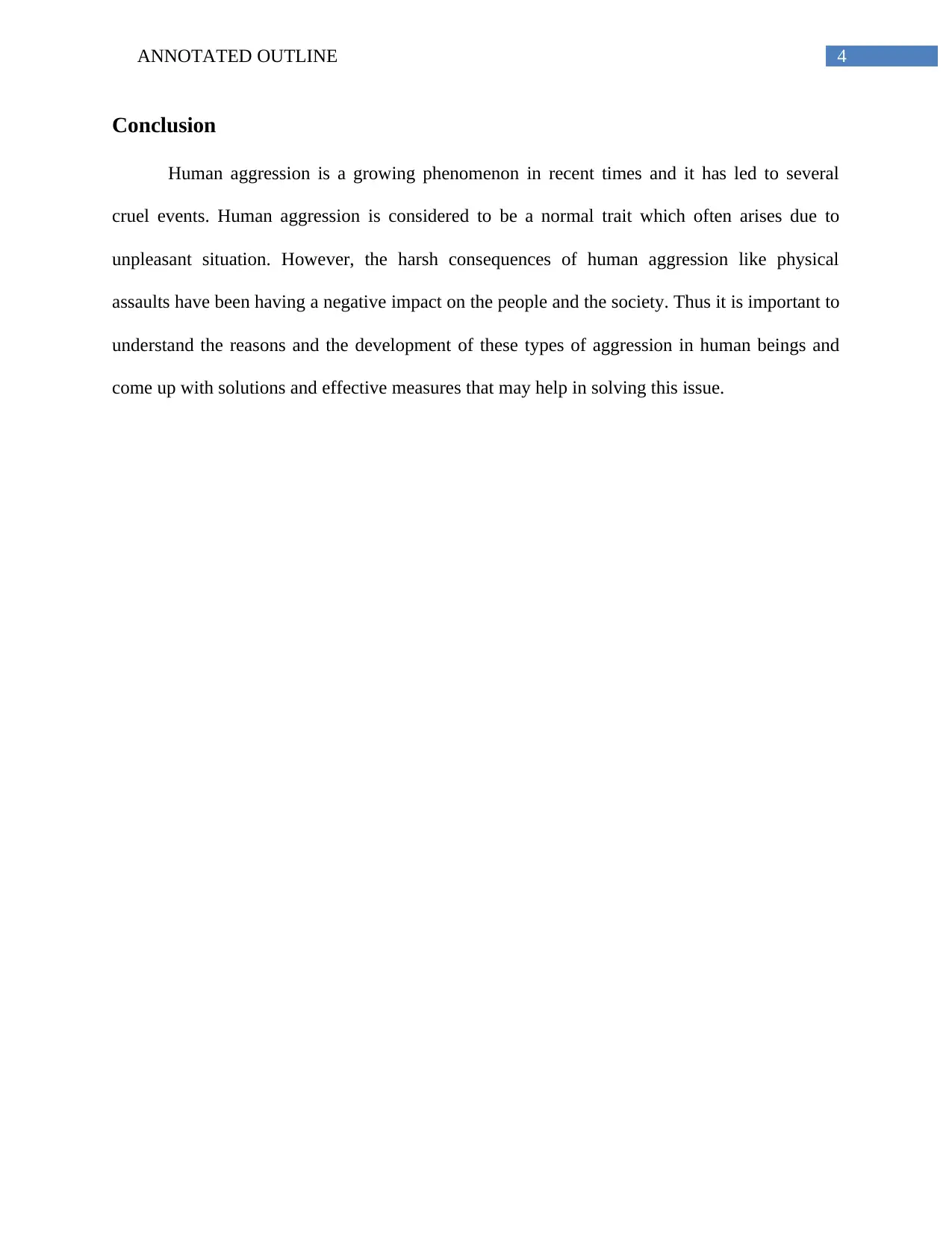
4ANNOTATED OUTLINE
Conclusion
Human aggression is a growing phenomenon in recent times and it has led to several
cruel events. Human aggression is considered to be a normal trait which often arises due to
unpleasant situation. However, the harsh consequences of human aggression like physical
assaults have been having a negative impact on the people and the society. Thus it is important to
understand the reasons and the development of these types of aggression in human beings and
come up with solutions and effective measures that may help in solving this issue.
Conclusion
Human aggression is a growing phenomenon in recent times and it has led to several
cruel events. Human aggression is considered to be a normal trait which often arises due to
unpleasant situation. However, the harsh consequences of human aggression like physical
assaults have been having a negative impact on the people and the society. Thus it is important to
understand the reasons and the development of these types of aggression in human beings and
come up with solutions and effective measures that may help in solving this issue.
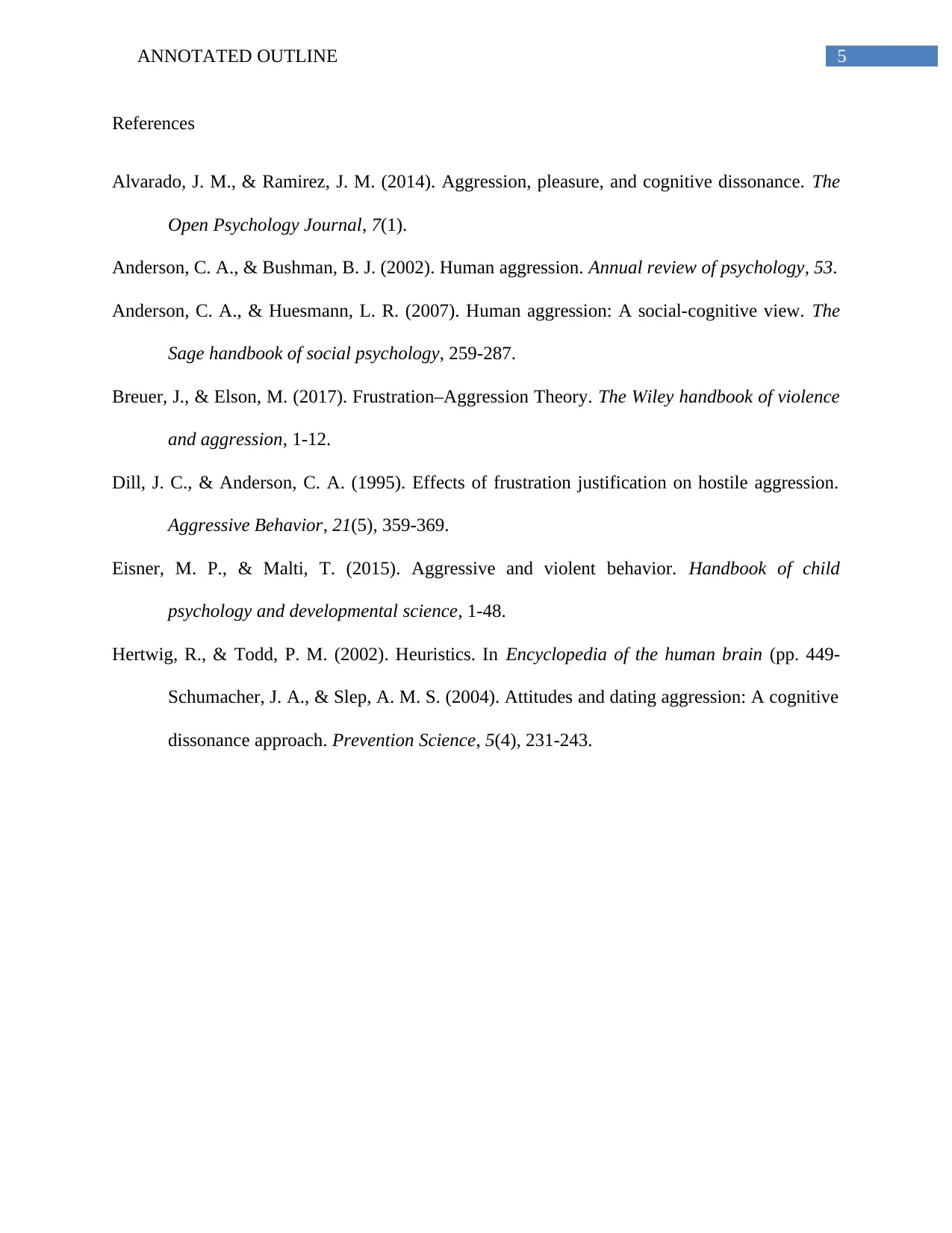
5ANNOTATED OUTLINE
References
Alvarado, J. M., & Ramirez, J. M. (2014). Aggression, pleasure, and cognitive dissonance. The
Open Psychology Journal, 7(1).
Anderson, C. A., & Bushman, B. J. (2002). Human aggression. Annual review of psychology, 53.
Anderson, C. A., & Huesmann, L. R. (2007). Human aggression: A social-cognitive view. The
Sage handbook of social psychology, 259-287.
Breuer, J., & Elson, M. (2017). Frustration–Aggression Theory. The Wiley handbook of violence
and aggression, 1-12.
Dill, J. C., & Anderson, C. A. (1995). Effects of frustration justification on hostile aggression.
Aggressive Behavior, 21(5), 359-369.
Eisner, M. P., & Malti, T. (2015). Aggressive and violent behavior. Handbook of child
psychology and developmental science, 1-48.
Hertwig, R., & Todd, P. M. (2002). Heuristics. In Encyclopedia of the human brain (pp. 449-
Schumacher, J. A., & Slep, A. M. S. (2004). Attitudes and dating aggression: A cognitive
dissonance approach. Prevention Science, 5(4), 231-243.
References
Alvarado, J. M., & Ramirez, J. M. (2014). Aggression, pleasure, and cognitive dissonance. The
Open Psychology Journal, 7(1).
Anderson, C. A., & Bushman, B. J. (2002). Human aggression. Annual review of psychology, 53.
Anderson, C. A., & Huesmann, L. R. (2007). Human aggression: A social-cognitive view. The
Sage handbook of social psychology, 259-287.
Breuer, J., & Elson, M. (2017). Frustration–Aggression Theory. The Wiley handbook of violence
and aggression, 1-12.
Dill, J. C., & Anderson, C. A. (1995). Effects of frustration justification on hostile aggression.
Aggressive Behavior, 21(5), 359-369.
Eisner, M. P., & Malti, T. (2015). Aggressive and violent behavior. Handbook of child
psychology and developmental science, 1-48.
Hertwig, R., & Todd, P. M. (2002). Heuristics. In Encyclopedia of the human brain (pp. 449-
Schumacher, J. A., & Slep, A. M. S. (2004). Attitudes and dating aggression: A cognitive
dissonance approach. Prevention Science, 5(4), 231-243.
⊘ This is a preview!⊘
Do you want full access?
Subscribe today to unlock all pages.

Trusted by 1+ million students worldwide

6ANNOTATED OUTLINE
I
I
1 out of 7
Your All-in-One AI-Powered Toolkit for Academic Success.
+13062052269
info@desklib.com
Available 24*7 on WhatsApp / Email
![[object Object]](/_next/static/media/star-bottom.7253800d.svg)
Unlock your academic potential
Copyright © 2020–2025 A2Z Services. All Rights Reserved. Developed and managed by ZUCOL.